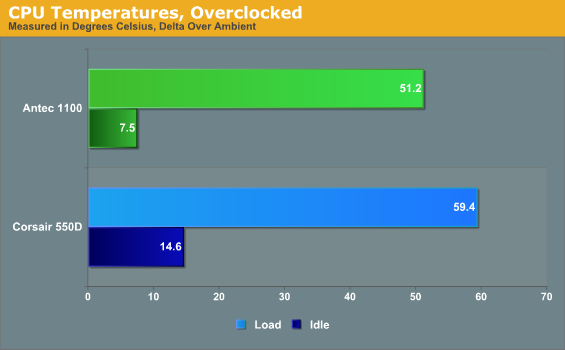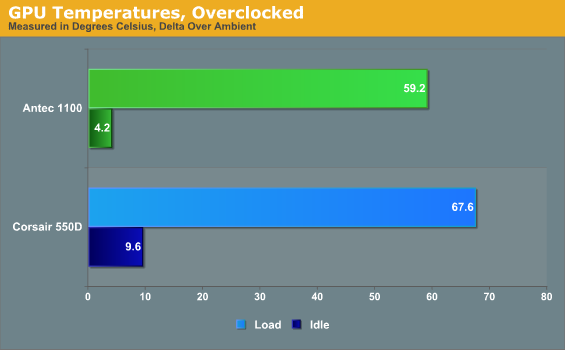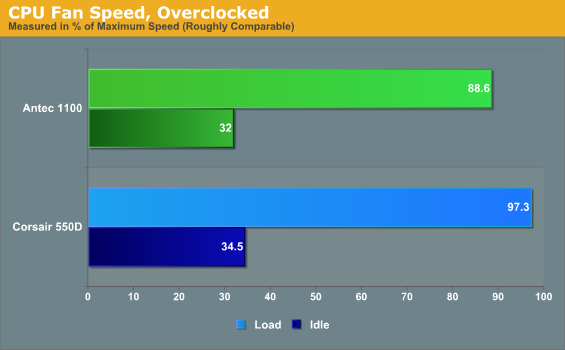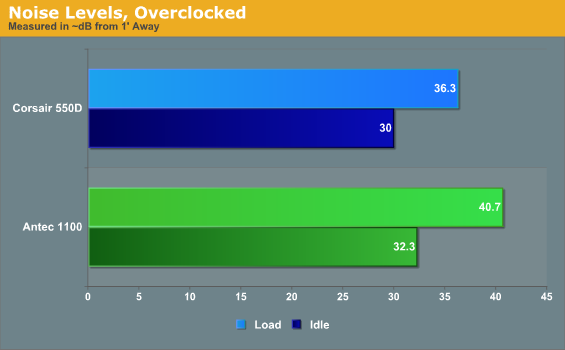Antec Eleven Hundred: The P280's Gloves Come Off
by Dustin Sklavos on April 9, 2012 12:00 AM EST- Posted in
- Cases/Cooling/PSUs
- Antec
- mid-tower
Noise and Thermal Testing, Overclocked
The Antec Eleven Hundred put in a strong showing with our stock settings, clearly offering a substantial amount of thermal headroom right from the factory. Hopefully the more open-air design will continue to pay dividends once we jack up the voltage on the CPU and the graphics card and overclock them both.



Antec's enclosure separates a lot more from Corsair's acoustically-oriented design once overclocks are applied, as the major components run much cooler at both idle and load. That's to be expected; the Eleven Hundred already proved it had plenty of thermal headroom and even here that continues. Ambient temperatures during testing hovered around 23C; if you do the math, even in a room that's pushing 90 degrees Fahrenheit (32C), the Eleven Hundred should still keep the components running well below spec temperature.



That headroom is borne out again when we look at fan speeds; while the Corsair 550D's more closed-off design results in our cooling system beginning to hit its limits, the Antec Eleven Hundred still has a bit more to go.
I don't intend to denigrate the 550D's thermal performance, though, because when you take a look at our noise levels you see where the 550D's strengths lie. The Eleven Hundred becomes very noticeable when stressed while the 550D does a better job of keeping a lid on the parts. Those fans may be working harder, but they're still ultimately working quieter in Corsair's case. This is the tradeoff users routinely have to make if they're not willing to spend up on something beefier like SilverStone's FT02 or Cooler Master's Cosmos II.










40 Comments
View All Comments
Stahn Aileron - Monday, April 9, 2012 - link
Would it be too much to ask that you actually place the ambient tempurature during testing somewhere on the graphs themselves so we have a readily accessible reference point right there on the graphs? It would also work as a reminder to readers what the conditions are.Dustin Sklavos - Monday, April 9, 2012 - link
The ambient temperature is going to vary from test system to test system, that's why I switched to listing the delta.Rick83 - Monday, April 9, 2012 - link
You did check, that the delta is a constant over ambient temperature though, did you? It may not be for every case. Also, of course, fan speeds will be impacted by ambient/internal temperature.If you can, you should probably run two series of tests, one in the morning and one in the evening, and then either average that or use one measurement, but at least comment the other. At least for noise, we need ambient temperature, as otherwise that value is completely without base for comparisons.
kandrtech - Monday, April 9, 2012 - link
Those familiar with thermodynamics, and the equations utilized, would agree that the delta approach is the best. Variances of a few (or 10) degrees on ambient will not appreciably change the delta results. By appreciably, I mean you'll see differences out to one or more decimal places . . . .niva - Monday, April 9, 2012 - link
Are you talking 10 deg C or F?Ideally your ambient temperature should be somewhere in the +/- 5 deg of 70 deg F. These are the normal temperatures most households are kept at. There may be a significant difference between the noise produced by components at 65 deg F, and someone's house which may be normally kept at 85 deg during the summer daytime because of lack of AC?
And I'm talking about idle situation here...
The point was valid, just include the temperature in your test data.
bobbozzo - Monday, April 9, 2012 - link
The article describing their new methodology for case testing seems to indicate that ambient temps are maintained between 71-74F.http://www.anandtech.com/show/5709/introducing-our...
ShieTar - Tuesday, April 10, 2012 - link
But those familiar with modern PC design are aware that fan-control systems generally try to achieve a constant CPU/GPU-temperature. Thus when you raise the ambient temperature to somewhat higher levels, CPU/GPU fans tend to speed up, giving you lower Delta-T values at increased noise.Thus it is important to still run these tests at comparable ambient temperatures, and if this is indeed checked at each test, it should be no problem to change the title of the temperature graph to read "Delta over ambient at 20+/-2°C". Or whichever is the range that is controlled and accepted by the tester.
O8h7w - Saturday, April 14, 2012 - link
I feel perfectly good about showing the temperature as delta above ambient instead of absolute temperature. But it seems many readers would like to see the ambient temperature at the time of testing reported as well, and I have to agree.The way of doing this that would make perfect sense in the graphs is to modify the labels to look like this:
Antec 1100
@ 23°C ambient
Lucian2244 - Monday, April 9, 2012 - link
Good review, i was wondering how it would look with a mATX in there.Is it just me or their cases get uglier and uglier ?
Iketh - Monday, April 9, 2012 - link
It's not you... this case is ugly... AND stupid...Enough with filterless side vents already! Why even have side vents? That's a damn 80's design, speaking figuratively...